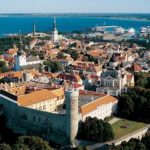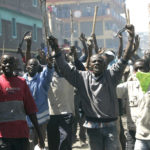A Lively Start
We started our visit to gay Estonia at a party. My husband Michael and I were invited to a celebration at EESTI LGBT (Estonian LGBT Association) office one evening to meet Brigitta Davidjants and her life-partner. Briggitta and I had corresponded before my arrival in Tallinn inquiring about LGBT life in Estonia. (This followed our visit to Lithuania and Latvia in the previous three weeks.) To our delight we were also met with Brigitta’s and her partner’s two cute blond infant children. It was a playful surprise to see them crawling on the floor and being picked up and played with by their parents and friends. (photo right, Tallinn central square)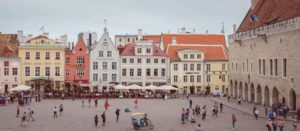
As we entered we were immersed in a swarm of about 50 LGBT locals gathered to observe the 6th anniversary of the center’s founding in 2011 with the purpose of serving the LGBT community mostly in the capital of Tallinn, a city of 415,000. Gathered together on this balmy late summer evening were LGBT friends, activists and supporters mostly women, with a handful of men. I asked my hostess Brigitta, a native of the city, where are the men? “Most of them (not all) tend not to be much involved in NGOs. Women in general find more time to support and participate in the center in addition to their daily jobs,” she said. “Men prefer to work within official institutions such as banks and corporations which are more ‘glamorous’ than human rights work.'” (In Estonia women are less empowered and less rewarded than men although women tend to be better educated.)
So it was, as the bubbly feminine energy filled all four rooms and the main hallway with chatter, laughter and camaraderie. It was a very warm and welcoming crowd. Everyone we encountered had a friendly face and a variety of hair styles and colors.
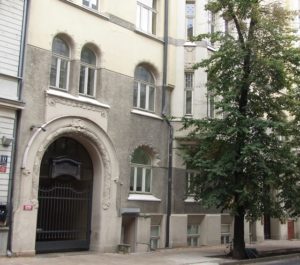
The Estonian LGBT Association (officially called the ‘OMA Center’ (OMA is short for ’oma maailma avardamise’, which in translation means ’broaden your world’) opened at a time when social attitudes toward queer folks were in flux. The initial years of vigorous resistance to gay life were in the past, mostly, and the current level of tolerance was taking serious hold in this conservative Lutheran society. (photo left, Art Nouveau-style entrance to OMA Center)
The EESTI Center’s rooms were decorated with rainbow-colored balloons and streamers as finger food was offered followed by anniversary cakes. Given the shouting, the boisterous games, baby-holding and feel-good camaraderie it was somewhat difficult to talk much with Brigitta. We agreed to meet again the next day when the premises were quiet and I could take photos of their library and cheerful offices.
Despite the chattering of voices Brigitta told me about one important matter in Estonia: in 2014 parliament had squeaked through a gender-neutral Civil Partnership Act on a close vote of 40 to 38. It was a major achievement that resulted from much lobbying and persuasion of the congress, a gain for the LGBT citizens and for the country itself as it continued its growth away from half a century of brutish control by the Soviet bear next door. The Civil Partnership Act came into effect on January 1, 2016. This was a milestone event also as Estonia became the first ex-Soviet country to legalize same-sex partnerships. The new law acknowledges civil unions for all couples, regardless of the gender of the partners, and grants same-sex couples rights and responsibilities similar to marriage between heterosexuals.
“By passing this law, Estonia made a leap towards a society that is more free, more equal and values human rights for all. The thousands of individuals who each in their own courageous way spoke out and took a stand for human rights and equality are an inspiration not only to everyone in Estonia but to other peoples and states in the region,” said Kari Käsper, Head of the Estonian Human Rights Center, a human rights watchdog NGO. (http://www.loc.gov/law/foreign-news/article/estonia-legalization-of-civil-partnerships/)
Regarding same-sex equality, many Estonians were opposed to the legislation and participated in public protests. Needless to say, all religious communities opposed it although the country is one of the least devout countries in the world: only 14% of the population declare a preferred religious affiliation. (https://en.wikipedia.org/wiki/Religion_in_Estonia) Despite vocal and sometimes hysterical opposition the bill was approved since it was supported by three main liberal (but not wholly united) political parties currently holding a majority. Much of the opposition also came from the sizable Russian minority in Estonia (nearly 30%) who were influenced by Orthodox attitudes.
(Role models for gay politicians in former eastern Europe are few, including the German Klaus Wowereit (former mayor of Berlin) and Polish legislator and mayor Robert Biedroń—who was interviewed by GlobalGayz several years ago.)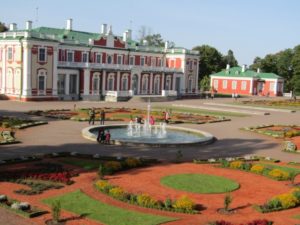
Neither of the other two Baltic countries, Latvia and Lithuania, also former Soviet satellites, have achieved this important partnership legislation yet. (http://www.lgbt.ee/estonia-became-the-first-ex-soviet-country-to-legalize-same-sex-partnerships/ ) The disempowerment of women in these countries has much to do with male-ego dominance, past and present, coming from the Soviet/Russian sphere of influence. (photo right, former royal palace now a museum)
The LGBT OMA Center
The Center has three main action programs:
(1) seminars and educational workshops to raise awareness and offer educational materials in Estonian society, such as police, judicial officials, medical workers, school teachers and religious leaders; (2) advocacy for equal rights legislation with parliament members, especially with prejudiced lawmakers whose homophobia blinds them to the inequality in the law; (3) support for LGBT individuals and their chosen families and families-of-origin by providing counseling and referral services for growth; (4) the Center also maintains a library of LGBT related books (fiction and non-fiction), information brochures about homosexuality and transgender health as well as other LGBT issues.
The OMA Center is also an important partner in organizing and promoting the annual Baltic Pride parade that rotates yearly among Estonia, Latvia and Lithuania. The colorful event started in Latvia in 2006 with some skipped years because of opposition and confusion. It has increased in popularity and participants every year since starting from a few hundred at first to now over 4000 celebrants and supporters in the 2017 event in Vilnius, Lithuania. Support also came from foreign LBGT organizations most notably RFSL from Sweden and Amnesty International as well as several foreign embassies as well as ILGA Europe, and local organizations. It is an important event, not just as a party but a strong political and human rights statement to the public and legislators that LGBT citizens will not accept second-class status in any of the Baltic countries. In 2017 it was held from July 6 to July 9 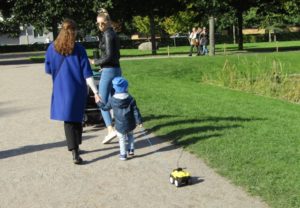 without significant disruption or threats of violence. (https://www.facebook.com/BalticPride/)
without significant disruption or threats of violence. (https://www.facebook.com/BalticPride/)
Because Estonia borders Russia and was once a Soviet territory many older people from Soviet times speak Russian as well as Estonian. Some speak only Russian. Efforts are underway to encourage more use of the indigenous language. A recent study of attitudes revealed that homosexuality among the predominant Russian speakers is less acceptable than among predominant Estonian speakers, partly no doubt due to Estonia having joined the Western-thinking European Union in 2004. 56% of the Estonian speakers supported the partnership law and 47% supported same-sex marriage, while among Russian speakers these figures were 21% and 20%, respectively. (photo left, mothers and children in central park)
A recent 2017 survey revealed that attitudes of Estonian people towards gays and lesbians have improved during recent years, but over half still regard homosexuality as somewhat or completely unacceptable. As usual the differences in attitudes are mainly associated with age, language and education. Nevertheless, the proportion of Estonian people regarding homosexuality as acceptable has grown remarkably: from 34% in 2014 to 41% in 2017 although homophobia is still entrenched in the public psyche. Many elderly Estonians still carry communist-era intolerance in mind, viewing homosexuality as a disease. Homosexuality was legalized in Estonia in 1992 almost immediately after independence from Russia. (https://humanrights.ee/en/topics-main/vordne-kohtlemine/attitudes-towards-lgbt-topics-estonia/)
A Chat with Brigitta Davidjants
Brigitta (photo right) is the public relations director for EESTI-LGBT organization in Tallinn for the past year. An attractive and articulate woman of 32, she is versatile in several languages—Russian and English, and Estonian, which is not surprising given the close proximity these different cultures in Europe. She is also the editor of the feminist outlet Feministeerium (available in English).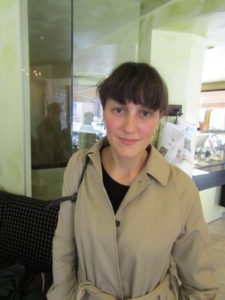
The EESTI Center offers youth support groups for different purposes such as Christians, trans youth and coming out as LGBTI. There are trainings for professionals like teachers to help them relate with trans students. It is not unusual for women to be more drawn to work with NGOs, especially young women who embrace change more readily than older women or men; society is changing but some resist it. Previously funding for EESTI came from NGOs such as the Soros Open Society charity (but not recently) and from public revenues from gambling casinos and taxes on tobacco, which also support social services in the country.
Brigitta reported that homophobic religious people have occasionally assaulted gay women, especially butch women as happened in the early years of Baltic Pride. Previously, men were assaulted by fundamentalists during Pride but these were not always reported out of fear of being outed in public. More recently such assaults are rare; Pride happens with little opposition thanks to growing tolerance, educational outreach and police protection.
The Center takes hate crimes and homophobia attacks seriously and keeps records of hate crimes and cooperates with police. More commonly however, Estonians are shy people and usually don’t attack others. Most aggression comes from poorly educated and unemployed male youth who join hate groups (outsiders) where they feel accepted. In 2017 there were no attacks against LGBTs during Baltic Pride. There were 2000 people in the Baltic Pride parade including politicians, feminists, male businessmen and activists; another 2000 observers attended the parade as onlookers, many with their children.
What is a Family?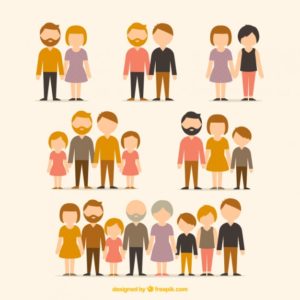
Brigitta has also written for publications. One of which is quoted here. In a recent post for IDAHO day in 1917, she wrote this comment about the meaning of ‘family’ [translated from Estonian]:
“IDAHO is a day that aims to draw attention to homo, bi and transphobia in society. This year IDAHOT focuses on families of all varieties.. This is a good subject, because there is always something to say about families. Sometimes it’s little daunting to think who is families is and who is not, especially for LGBT people.
“Eight years ago I worked in a diy-newspaper and I was interviewed by a second-rate reporter. At that time, there was a public debate about the right to self-determination in choosing a marriage partner. The reporter, obviously disturbed and homophobic, pretended to be shocked that family was still a woman and a man and not a woman who wants to marry her vibrator. I asked my colleague whether we still have to print this kind of rubbish. My colleague said that the reporter’s question should be printed as well as the absurd answer. Also printed was the idea whether two women can name themselves with each others’ name or can they only say they are just girlfriends.” (image left from Freepik.com that accompanied Brigitta’s commentary)
Brigitta continued: “This kind of thinking blew me away at that time; such ideas still are going on despite the social progress in recent years. Honestly, where does the argument of deciding if someone’s family is or is not a family?
“Family is when people decide they are family. A woman and a man and a child are a family. And woman and woman and child are family. And a man and a man and a child are a family. And a child and grandma and grandpa are family. Because a family is a condition of giving and taking love with other people–feelings, relationships, common life and keeping each other. A family is ‘content’, not simply a ‘form’. It’s that simple.”
Also see:
Gay Life in Lithuania
Gay Life in Latvia
Estonia News & Reports

